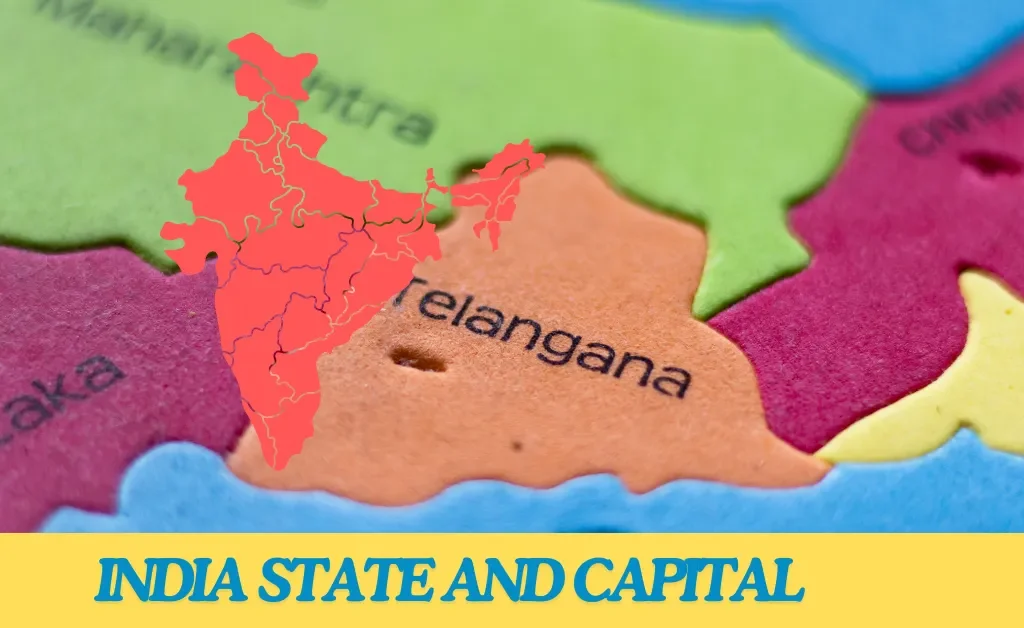Table of Contents
Introduction to States and Capitals of India 2024
India, the world’s largest democracy, is a land of diverse cultures, languages, and geographical landscapes. The country is divided into 28 states and 8 Union Territories (UTs), each contributing to the nation’s unique identity. Understanding the structure of these states and UTs is vital for grasping the complexities of India’s administrative and political setup.
The states of India are more than just geographical divisions. They represent linguistic, cultural, and historical identities that have evolved over centuries. Similarly, Union Territories, which are directly governed by the Central Government, play a crucial role in the nation’s administrative framework.
The purpose of this article is to provide an updated list of states and UTs along with their capitals as of 2024. We will explore the significance of each capital city in terms of governance, culture, and economy.
Overview of the States and Capitals of India 2024
India’s states are the backbone of its federal structure. Governed by elected state governments, they possess their own legislative assemblies and have autonomy in certain areas. Each state contributes uniquely to India’s overall political, economic, and cultural landscape.
India’s states are primarily based on linguistic boundaries, a decision that dates back to the reorganization of states in 1956. The division of powers between the states and the central government allows for a balance in administration, promoting both unity and diversity within the nation.
Indian Union Territories: A Special Administrative Division
Unlike states, Union Territories are regions governed directly by the Central Government. UTs hold strategic importance and may not have the same degree of legislative autonomy as states. The number of UTs in India has fluctuated over the years due to changes in administrative policies and the creation of new territories.
The 28 States of India
India’s 28 states each have distinct identities. From the bustling cities of Maharashtra to the tranquil landscapes of Kerala, every state offers a unique blend of tradition, culture, and modernity. The historical background of Indian states is deeply rooted in regional kingdoms, colonial histories, and post-independence developments.
Here is a list of the 28 Indian states and their capitals:
Indian States and Capitals
| State | Capital |
|---|---|
| Andhra Pradesh | Amaravati |
| Arunachal Pradesh | Itanagar |
| Assam | Dispur |
| Bihar | Patna |
| Chhattisgarh | Raipur |
| Goa | Panaji |
| Gujarat | Gandhinagar |
| Haryana | Chandigarh |
| Himachal Pradesh | Shimla |
| Jharkhand | Ranchi |
| Karnataka | Bengaluru |
| Kerala | Thiruvananthapuram |
| Madhya Pradesh | Bhopal |
| Maharashtra | Mumbai |
| Manipur | Imphal |
| Meghalaya | Shillong |
| Mizoram | Aizawl |
| Nagaland | Kohima |
| Odisha | Bhubaneswar |
| Punjab | Chandigarh |
| Rajasthan | Jaipur |
| Sikkim | Gangtok |
| Tamil Nadu | Chennai |
| Telangana | Hyderabad |
| Tripura | Agartala |
| Uttar Pradesh | Lucknow |
| Uttarakhand | Dehradun |
| West Bengal | Kolkata |
The 8 Union Territories of India
Union Territories in India are often smaller in size compared to states and hold strategic political and economic importance. Some UTs like Delhi and Puducherry have partial statehood with their own legislative assemblies, while others are fully governed by the central administration.
| Union Territory | Capital |
| Andaman and Nicobar Islands | Port Blair |
| Chandigarh | Chandigarh |
| Dadra and Nagar Haveli and Daman and Diu | Daman |
| Delhi | New Delhi |
| Jammu and Kashmir | Srinagar (Summer), Jammu (Winter) |
| Lakshadweep | Kavaratti |
| Puducherry | Puducherry |
| Ladakh | Leh |
This will create a nicely formatted table in Word with the Union Territories and their capitals. If you need any further assistance, feel free to ask!
The Role of Capitals in Indian States and Union Territories
Capitals are more than just administrative centers; they play a crucial role in the political, economic, and cultural fabric of their regions. Each state and Union Territory capital serves as the seat of government, housing essential offices such as the legislature, executive bodies, and judicial establishments. These cities also act as a hub for major decisions, both at the state and national levels, influencing policies that shape the country.
Economic and Infrastructure Development: States and Capitals of India 2024
Capitals often lead in infrastructure development and economic activity. They are the primary beneficiaries of state budgets, often witnessing superior facilities, better connectivity, and advanced technology in sectors such as education, health, and transportation. This often makes capitals the face of the state or UT, attracting investments and tourism.
Cultural and Historical Importance: States and Capitals of India 2024
Many capitals, like Jaipur, Kolkata, and Chennai, are rich in cultural heritage. These cities have historically been centers of art, literature, and architecture, carrying forward a legacy that is often synonymous with the identity of their respective regions. For instance, Jaipur, the capital of Rajasthan, is world-renowned for its palaces, forts, and vibrant traditions, while Kolkata has a rich literary and artistic legacy.
List of 8 Union Territories and Their Capitals
The Union Territories in India have unique governance structures and are directly administered by the Central Government. Some, like Delhi and Puducherry, enjoy partial statehood with their own legislative assemblies. Others, like Lakshadweep and Andaman and Nicobar Islands, are directly controlled by the Central Government but hold great importance in terms of strategic and geographic positioning.
– Delhi – New Delhi: As the capital of India, New Delhi holds a dual role, serving both as the seat of the national government and the capital of the Union Territory of Delhi.
– Jammu and Kashmir – Srinagar (Summer), Jammu (Winter): After the bifurcation of Jammu and Kashmir in 2019, it became a Union Territory with two capitals, each serving for different seasons.
How Indian Capitals Have Evolved
The capitals of Indian states and Union Territories have seen significant evolution over the years, driven by socio-political changes, economic growth, and administrative needs. Post-independence India witnessed the establishment of several new capitals, while others were transformed to accommodate growing populations and modern requirements.
For example, Chandigarh, serving as the capital for both Punjab and Haryana, was designed by the famous architect Le Corbusier, symbolizing India’s modern outlook after independence. On the other hand, Hyderabad, the capital of Telangana, has grown into an IT hub, attracting global tech companies.
Factors Influencing Capital Selection:Introduction to States and Capitals of India
– Historical Importance: Many capitals, such as Patna (Bihar) and Bhopal (Madhya Pradesh), were chosen for their historical significance.
– Geographical Location: Capitals like Lucknow (Uttar Pradesh) and Dehradun (Uttarakhand) were selected due to their central positioning within the state, making administration more effective.
– Economic Potential: Cities like Mumbai (Maharashtra) and Bengaluru (Karnataka) have evolved from administrative capitals to economic powerhouses.
The Economic Impact of State and Union Territory Capitals
Capitals, by their very nature, are centers of economic activity. These cities tend to attract large-scale industries, multinational corporations, and major businesses due to their infrastructure, access to government resources, and superior connectivity. For instance:
– Mumbai, as the capital of Maharashtra, is the financial capital of India, home to major stock exchanges, banks, and financial institutions.
– Bengaluru, the capital of Karnataka, has earned the nickname “Silicon Valley of India” due to its booming tech industry.
– Chennai, capital of Tamil Nadu, is a hub for automobile manufacturing, information technology, and healthcare.
Capitals are also prime locations for higher education institutions, research centers, and industries that contribute significantly to the state and national GDP.
State Capitals and Their Cultural Significance
The capitals of Indian states are often the heart of their respective cultures. These cities host annual festivals, art exhibitions, cultural performances, and more, showcasing the diversity and richness of Indian traditions. For instance:
– Kolkata, the capital of West Bengal, is known as the cultural capital of India. It is famous for its literary heritage, music, art galleries, and festivals like Durga Puja.
– Jaipur, the capital of Rajasthan, represents the grand history of the Rajputana kings, with its palaces, forts, and colorful cultural events like the Jaipur Literature Festival.
The influence of these capitals often extends beyond their borders, shaping cultural narratives at both the regional and national levels.
Union Territory Capitals and Their Unique Cultural Identities
Union Territories, despite their smaller size compared to states, also have rich cultural landscapes. Capitals like Puducherry and Leh (Ladakh) are well-known for their unique blend of culture, history, and modernity.
– Puducherry reflects a unique mix of French colonial architecture and Indian traditions. It is a peaceful coastal city known for its spiritual retreats and serene beaches.
– Leh, in Ladakh, represents the stark beauty of the Himalayan landscape, along with a vibrant Tibetan Buddhist culture that has thrived for centuries.
These capitals play a significant role in preserving the cultural heritage of their regions while also embracing modernization.
Geographical Significance of State and Union Territory Capitals
Many state and Union Territory capitals are strategically located, either because of their accessibility or their geopolitical importance. Capitals like Shimla (Himachal Pradesh) and Dehradun (Uttarakhand) are located in hilly regions, which play a crucial role in defense and environmental preservation.
Strategic Importance: States and Capitals of India 2024
Some capitals are also significant from a geopolitical perspective. For instance, Srinagar and Leh are crucial for India’s defense due to their proximity to international borders. Capitals like Port Blair (Andaman and Nicobar Islands) are vital for securing maritime borders.
FAQs
States and Capitals of India 2024
1. Which is the largest state in India by area?
– Rajasthan is the largest state in India by area.
2. How many states and Union Territories are there in India in 2024?
– As of 2024, India has 28 states and 8 Union Territories.
3. What is the capital of Telangana?
– Hyderabad is the capital of Telangana.
4. Why does Jammu and Kashmir have two capitals?
– Jammu and Kashmir has two capitals due to its geographical and climatic conditions. Srinagar serves as the summer capital, while Jammu serves as the winter capital.
5. Which Union Territory has its own legislative assembly?
– Delhi and Puducherry have their own legislative assemblies, allowing partial autonomy in governance.
6. What are some unique features of India’s Union Territory capitals?
– Capitals like Leh (Ladakh) are known for their natural beauty and cultural uniqueness, while New Delhi is the center of political power in India.
Conclusion
India’s 28 states and 8 Union Territories form a rich tapestry of governance, culture, and history, with their capitals acting as the focal points of development and administration. As India progresses toward modernization, these capitals will continue to play a vital role in shaping the country’s future while preserving its diverse heritage.


